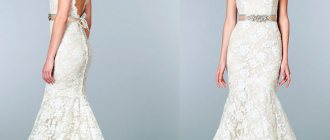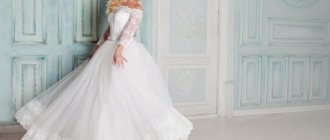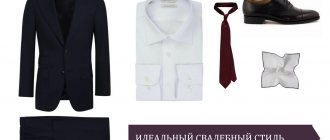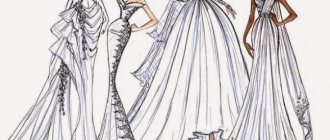The choice of outfit style depends only on the preferences of the bride herself, but in the majority, girls choose decorations with a classic full skirt. Rings, crinoline, and a cover under a wedding dress help create that very pomp. You will learn below how to choose the right accessory and complete the look.
What is it and why is it needed
A petticoat (also sometimes called a crinoline) is a special wardrobe item that is worn under a dress. It is sewn mainly from tulle. What is it for? Its main purpose is to give shape to the skirt and fullness to the dress.
Many people think that such an important wedding wardrobe accessory is very bulky and inconvenient. However, this is a misconception - on the contrary, it takes on the weight of the skirt and creates a dome, a space around the legs.
In this way it solves many problems:
- gives the dress the necessary shape,
- the bride’s legs become spacious and not hot,
- makes it easier to move - you don’t need to hold the skirt, it doesn’t wrinkle when walking
- gait acquires lightness, solemnity, gracefulness
- prevents you from getting tangled in your skirt when moving
So, if you choose the right style, it will not cause problems with moving and dancing, but on the contrary, it will help.
In order to choose the right model, you need to understand that there are several types. Your choice will depend on the style of your wedding dress and how full of a skirt you want to get in the end.
What is crinoline for?
- Increase in volume. A dress with a crinoline looks very lush and makes the bride look like a princess from a cartoon
- Changing shape. In addition to adjusting the volume, you can also change the shape of the outfit.
- Fixation of the form. It often happens that the skirt gets tangled in the legs when walking and thus gets in the way. This is where crinoline comes to the rescue, fixing the shape and making it easier for the bride to move.
- If you have a petticoat, your legs will not be hot if the wedding is scheduled for the summer or if there are too many guests in the room. This is especially convenient when the dress is multi-layered and made of heavy fabric.
- Fits your silhouette and can make your waist look a little smaller.
Varieties
First, you need to take into account that even if you choose the right style, if it is the wrong length, you are guaranteed inconvenience. Too short will look ridiculous, and too long will cause inconvenience when walking. Therefore, the recommended length of a petticoat for a floor-length dress is 120 - 150 cm. Or you can follow the rule: the distance from the floor to the edge of the crinoline should be 10 - 15 cm.
With hard rings
This is a classic crinoline. Such models for fluffy dresses are sewn on a rigid mesh and can have from one to seven rings. Due to their rigidity, they perfectly retain their volume and shape. Such a petticoat with rings has the advantage that the bride is not constrained in her movements and will not get tangled in the skirt (due to the space it creates). It's also quite cheap.
But this crinoline also has disadvantages. For example, when getting into a car, it can rise, which creates inconvenience. Also, if the dress is made of thin fabric, the rings underneath will stand out. Therefore, such a petticoat should be chosen for an outfit made of thick fabric or with a multi-layered skirt.
With soft rings
This is a lighter option; the fact is that it is based on fabric and flexible plastic rings. The advantages of this type are its invisibility, it does not stand out so much under the skirt of a dress even made of light fabric, and also the fact that the rings do not rise during landing.
Jest
This fluffy tulle petticoat consists of five tiers of fabric. Can be used both with and without rings (for example, for an Empire style outfit). A wedding dress without rings is, of course, lighter. However, if rings are not used, it will not be possible to achieve much fullness in the skirt, and again the problem of tangling in the skirt arises.
With a train
The point of sewing a petticoat for a dress with a train is the same as in the options discussed above: fabric or mesh frills are sewn over the frame with rings. However, its cost will be higher, since the train needs additional support and the frame lengthens. It is a little more difficult to find them in general sale; such models are often sewn to order.
This model also has a drawback - when sitting down, it can be exposed. This is unacceptable because the petticoat is part of the underwear. Also, when the bride sits down, the train of the dress can lie in one direction, and the frills of the petticoat in the other.
Without rings
Such multilayer structures have a number of advantages:
- not visible under a skirt made of thin fabrics;
- look impressive on shortened dress models;
- They allow the bride to sit in a comfortable way and not worry about the rings (they are not here).
But there are also disadvantages:
- with their help you cannot achieve the same pomp as with rings
- they create a lot of extra layers, which is difficult and unpleasant in hot weather
- It’s not convenient to walk with them if the dress is floor-length
Selection rules
Choosing the right petticoat for a wedding dress with rings is not so easy. Here it is necessary to start from the style of decoration, taking into account the pomp of the dress required, and the general atmosphere of the wedding.
For a full-length dress, a heavy crinoline is used. Such outfits look chic; they are mainly used at the official part of the event and photo shoot. For a celebration, you should choose lighter outfits where rings are not needed. Using multiple dresses allows the bride to stay fresh and not tired for the rest of the evening. At the same time, changing several clothes will surprise the guests and give the wedding itself a special touch of chic.
How many rings do you need?
Here everything will depend on the model of the dress you choose:
- "Empire" and straight-cut dresses can be complemented with petticoats without rings;
- “Mermaid” will need options with 1-2 rings;
- two and three rings are suitable for “Princess” and “A-line” outfits;
- but four or five rings suggest an exceptional ball gown.
Wedding dress models
Wedding dresses can be classified according to a variety of parameters. First of all, this is their length:
- Short - mini. Micros are practically never found.
- Dresses of medium length - midi. From mid-calf to ankle.
- Maxi to the floor. The most common length of wedding dresses.
- Dresses with gradient hem length.
According to the silhouette, the following styles are distinguished:
Ballroom. It involves a tight-fitting bodice and a loose, often multi-layered skirt. Almost always there are one or more petticoats, and it is possible to use a hoop.
Empire style, as well as the closely related Greek/antique style. High waist, lots of draperies on the chest and under it, short sleeves, or no sleeves at all. One of the most advantageous styles for sewing yourself.
Mermaid/fish - the upper part of the dress is tailored exactly to the figure, hugging the body as much as possible up to the hip or knee, below the skirt widens quite sharply towards the hem. Most often, the pattern is used for a year or a cut-off bottom of the dress.
Mermaid fish for the perfect figure
Princess/A-line. As a rule, sleeveless, the upper part is represented by a bodice, the panel of the skirt is an A silhouette.
Straight dress. Smoothly follows the contours of the body, but without being too tight. The skirt widens slightly towards the hem.
Price
Usually wedding dresses are sold without petticoats. Therefore, when planning your budget for its purchase, do not forget to allocate a separate article for this important detail of your holiday outfit.
Prices can vary greatly depending on the model and materials that were used to make it. A crinoline can cost from 50 rubles, but a tulle petticoat costs no less than 1,300 rubles.
The main thing is that you don’t even think about spoiling an expensive outfit with the cheapest crinoline; it may not hold its shape well or have fragile rings that can break when fitted. This is not something to skimp on.
Tip 3. Order your dress online
If you don’t know where to buy a wedding dress cheaper, we will continue the topic of online orders. We are all familiar with popular Chinese websites where you can buy everything from a circular saw to a wedding dress. The main thing when making a purchase is to be guided by the following rules:
- in the search filter, specify all the necessary parameters: size, style, type of fabric, skirt length, etc.;
- carefully read reviews of the product: how long did it take to arrive, what is the quality, does it correspond to the size chart;
- look at those products with the most reviews, preferably with real photos;
- choose stores only with high ratings and good reviews;
- Monitor the delivery: as soon as the delivery deadline expires and the goods have not yet arrived, open a dispute with the seller (you will either get your money back or extend the buyer protection period).
It is better to order a dress in advance - at least three months in advance, but better yet six months in advance. Because it may arrive with a delay or be completely lost during delivery. And also, it may have to be adjusted to fit your figure.
DIY petticoat
If you want to save money, or you are a creative person who wants to sew a tulle petticoat with your own hands, then you can try it!
On the Internet you can find many verbal descriptions of how to sew different models from mesh or tulle. However, it seems to me that it is better to see how a professional does it once.
So, when you go to the salon to buy your dream wedding dress, don’t forget to choose the right petticoat to go with it. It must match the model of your dress and be the correct length. But the main thing is that you should feel comfortable and comfortable, because you will spend more than one hour in it.
How to properly starch a petticoat for children's and adult dresses at home?
Today, not every housewife knows how to starch things correctly. However, this procedure is sometimes necessary in our time. Starch will help give your outfit an unusually fluffy look and a pretty perfect shape, the main thing is to know how to do everything correctly.
- Whatever dress we starch the petticoat for, it should be washed first. This must be done so that after all manipulations with the product there are no stains or streaks on it.
- So, let's move on to preparing the solution: for 1 liter of water you need to take 4 tablespoons of starch.
- Mix all the starch thoroughly in a glass of water, pour the rest of the water into a saucepan and bring to a boil. Next, pour the water and starch from the glass very slowly into the boiling water, while stirring constantly.
Starching a petticoat
- Bring our solution to readiness. Cooking time is approximately 5-7 minutes. As soon as the liquid becomes transparent and the consistency resembles jelly, the solution is ready. We wait until the liquid cools down.
- If you notice that there are lumps in the solution, they need to be removed. To remove them, pass the starch paste through a sieve.
- It is important to know that if your petticoat consists of several tiers, then you need to start starching the product from the bottom tier. All tiers are starched separately.
- So, to starch the petticoat, dip it into the prepared solution and hold it for about 7 minutes. In this case, you can move the item from side to side, but do not remove it from the solution.
- When you take out your petticoat, you don’t need to wring it out, except very lightly.
- Then we place the product on a previously prepared surface (cover the surface with a clean sheet).
- As soon as you see that the petticoat is barely damp, start ironing.
You can read more about starching different types of fabrics here.
21st century
Square dancer, 2006
Crinolines continue to be worn into the 21st century, typically as part of formal outfits such as evening dresses, prom dresses, quinceañera dresses and wedding dresses. 1950s and 1960s style mesh crinolines are a traditional element of square dance and clog costumes. They are also a popular outfit for attending 1950s and 1960s rockabilly-inspired events such as Viva Las Vegas. The steampunk movement also used cage crinolines along with other 19th century fashion elements such as corsets and top hats for its costumes.
Wedding dress, 2005
In some contexts, the traditional hoop crinoline may be seen as controversial, as in early 2015 when the University of Georgia reportedly required that hoop skirts not be worn at certain fraternity events due to their perceived association with Southern belles and slave owners, the highest socio-economic strata of society. classes of the American deep south. The reason for the proposed ban was due to the SAE racism incident earlier that year, and several articles noted that it was a deliberate attempt to avoid accusations of racial insensitivity among the University of Georgia fraternities. It has been noted that hoop skirts and crinolines were worn by both black and white women of all classes and social strata during the historical period in question, and that despite social associations, they were not exclusive to the Southern belle image.
Story
In England, crinoline became known in 1829; by 1850 the word referred to a domed, gathered skirt, the shape of which was given by numerous petticoats. In the period 1851-1856, lightweight fabrics such as muslin and tarlatan were used for summer crinolines; after 1852 la gaze cristal
(iridescent taffeta, damask, brocade, silk, satin - fabrics made from threads of two different colors, woven at the same time). Until 1856, 6 more petticoats were worn under the overskirt; their production became easier with the widespread use of sewing machines in 1857. "Artificial crinolines" on steel hoops were introduced from 1859; with them there was a refusal of petticoats.
Sometimes the invention of crinoline in the modern sense is associated with the French Empress Eugenie, who allegedly introduced it during pregnancy; in reality it is just a legend. The crinoline was invented and further promoted by Charles Frederick Worth. One day his wife sold a pair of crinoline dresses to the wife of the Austrian ambassador, Pauline von Metternich, and the Empress became interested in the idea, which allowed the crinoline to quickly become fashionable.
Both at the court of Empress Eugenie and at the court of Queen Victoria, the ceremony prescribed the adoption of “noble” poses; the crinoline provided great opportunities for this, and also made it possible to outwardly observe the prescribed modesty (the width determined the distance).
The crinoline was in fashion strictly between the London Exhibition of 1851 and the World Exhibition in Paris of 1867.
Literature
- Lyudmila Kibalova, Olga Gerbenova, Milena Lamarova.
Illustrated encyclopedia of fashion. - Prague: Artia, 1966. - Bradfield, Nancy.
Costume in detail: women's dress 1730—1930 (English). - New ed.. - Kent, England: Eric Dobby, 2005. - ISBN 1-85882-038-3. - Cunnington,, C. Willett;
Lucas, Phyllis Cunnington; illustrated by Phyllis Cunnington, Cecil Everitt Catherine. Handbook of English costume in the nineteenth century (English). - 3rd ed.. - London: Faber, 1970. - ISBN 0-571-04703-3. - Webber, Elizabeth Ewing;
with illustrations by Jean. Fashion in underwear (English). - Repr.. - London: Batsford, 1972. - ISBN 0-7134-0857-X. - Levitt, Sarah.
Victorians unbuttoned: registered designs for clothing, their makers and wearers, 1839—1900 (English). - London: Allen & Unwin, 1986. - ISBN 0-04-391013-0. - Waugh, Norah.
Corsets and crinolines (English). — rev. ed.. - London: Batsford, 1987. - ISBN 0-7134-5699-X.
Problems
The crinoline often became the object of satire; it was compared to a cage in which a woman is imprisoned; its diameter (up to 180 centimeters) could create problems in passing through doorways. If you fell or failed to sit down, the crinoline could bend in the opposite direction, and the structure as a whole was difficult to transport in luggage.
Finally, crinoline was dangerous because its owner could not always trace its edges: for example, in 1857, a New York Times correspondent described a case in which the clothes of a girl who went outside caught fire. A cigarette rolled under the hem of her dress in a cafe, but the fire did not break out due to lack of oxygen until the girl walked down the street. Passers-by helped the girl, and no one was hurt. In The Times
reported the case of Margaret Devey, 14, when a working maid's dress "stretched out over the crinoline" caught fire. The Jury returned a verdict of "Accidental Death caused by Crinoline"; other similar cases are known - for example, the death of two sixteen-year-old maids in 1863.
However, there is also a known case of a crinoline saving a life: in 1885, Sarah Ann Henley jumped from the Clifton Bridge after a quarrel with her lover and survived a fall from 75 meters, since the crinoline allegedly softened the fall, playing the role of a parachute. Although whether the crinoline helped her survive is a matter of debate, the incident has become a well-known Bristol legend.











